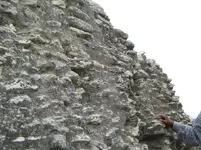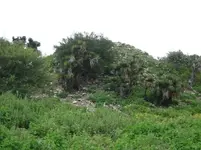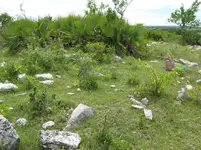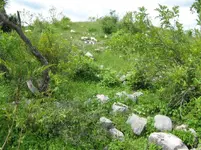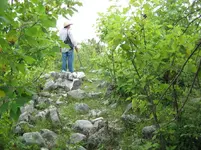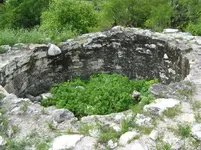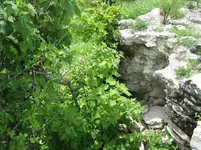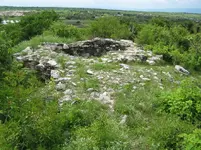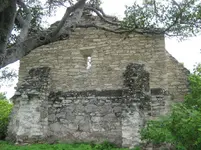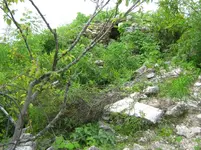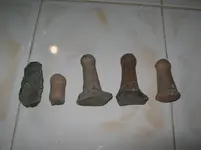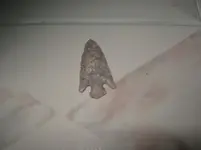Re: Moctezuma's Tomb
Oh, man!!!
Yesterday, Independence Day, was the day. Last Sunday, the pastor's sister-in-law pointed me at her brother, and asked him when he could accompany me to the Tetele de Moctezuma. We discussed it, and agreed on Thursday at 2 pm.
Later, my wife said, "They probably forgot Thursday is Independence Day, so they may not be able to go."
Nope, when I showed up Thursday, they said, "Let's go." And, we did. We were out walking around the hills for around 3 hours. I don't do a lot of walking long distances in the warmer, sunnier months, so when I got home, I had a long nap.
I have so much to say about what I saw, I hardly know where to start, and also have several pictures. Please be patient with me. This is going to take time to sort out.
This is a major archaeological zone!
It is also an unregistered, major archaeological and historical zone. That means the government archaeologists do not know of its existence, as far as we can tell.
I call it a zone, because from the first place of interest to the Tomb of Moctezuma, which turned out to be the same one I told about before, my GPS showed 2.23 Km, or just under 1.25 miles. The first item of interests was assigned Waypoint 49 by my GPS, the last one, the Tomb of Moctezuma, was #56, which should explain why I say it's a zone.
Along that distance, were thus 8 items of interest, from ancient burials to a large oven, of uncertain age, probably for 'cal', what they call quicklime here. Obviously, the ancient burials would seem to be the most important items, no?
We left the village and after some time, my principal guide stopped and pointed at some rocks that seemed to be randomly placed, until he pointed them out. Then, it became obvious they made sort of a ring or circle.
He said in the past, in a time of hunger, local men went out and dug there. In the center of that ring, they found four skeletons, only bones and some hair still remained. Also, old things which they sold to buy food for their families. They covered the bones again. They described the position of the bones to be the standard fetal position of buried bodies.
As we walked on, he pointed out other places where they dug and found skeletons. So, it would seem as if a GPR would be needed here if a dig is ever done. It may well be a major ancient cemetery.
Though one can never be sure, there is a high probability those bones were buried before roughly 1600. The LDS (Mormon) database shows the first document for the local church at 1609, with many as of 1620. It is unlikely burials in other cemeteries would have been done after the Catholic priests came here. Earliest possible date estimations would have to be done by scientific dating techniques.
Then we came to a large construction, which they named as on oven. The limestone based rock, which is actually travertine marble, can be cooked, and becomes quicklime, they call it cal. It is used on construction, though not as strong as Portland Cement, also for 'stucco' finishes in houses, called revoco. Also, it is used to make tortillas. The corn is put in water, with cal, and boiled to loosen the skins of the kernels before grinding, because the skins do not make for good tortillas.
We have no idea if this oven is more or less modern, that is, in the last two centuries, the Hispanic era, or ancient. As we have seen in the old house ruins, rock structures here can last to some degree, some hundreds of years. The oven looked usable if one dug out the debris which has filled it up. Pictures below, of course, as I sort them out. It is like ten or more feet across, and depth is unknown.
There was an amphitheater looking excavation, though I must wonder if it might have been a place where they dug out marble for the oven. But, the locals said they believed it was a place where an old traditional game of ball was played. The picture will not show that shape, because of the tree growth.
There was a large, raised area, though no visible construction seemed to be on it. They viewed this as a pyramid, though in no place but the Tomb itself was there any visible, clearly delineated construction as we think of when we use the word pyramid.
Several times as we walked along, he stopped, reached down and handed me something which he had found. He said they were legs of cajetes. These are bowl like things with legs, and they are used for mixing or grinding foods or medicines. I cannot find cajetes in my dictionary, but molcajete is one name for such an item. My wife, though we have a power blender, still at times uses her old, traditional molcajete when cooking.
He said they are clay, but are not 'cooked', which I think we would say baked. I don't know how they have lasted such a long time, but there they were on a hilltop lying in the dirt. I can only imagine what there might be, below the dirt.
There was one thing which they said was part of a stone hatchet. I don't buy it, but what do I know.
I will eventually have a photo of all five objects. I cannot speak for the age of the legs, except the ones for sale today are indeed baked clay.
We came to an old building. They called it a hacienda. It is actually in good shape, except the roof is gone, and the door is gone, but the walls are in good shape. There is a natural bee hive in the end. The local history says this building was built in the early days of Porfirio Diaz, that is, the latter part of the 19th Century, and soldiers were stationed there, and in several similar buildings in the area to maintain order.
Hey, I wouldn't mind buying that old house and fixing it up but it is on ejido land, that is, communal land, and cannot be sold without legal authorization.
We kept walking, and I noticed we were pretty far from the village. They said we are going to the Tetele. It came over me. This is the same Tomb of Moctezuma I went to before. It was. To be sure, I ran a GPS distance to/from from the original coordinates, and it said .01 km, or roughly ten meters. Yep, same location.
I had a question from a poster here about the construction of the visible wall in the ruin, and while I was there, I set out to answer it.
This time they were more patient than my company last time, so I struggled my way up to the visible wall.
My guide said it was made by using white powder, made from a certain type of rock, ground up, and placed wet between the rocks. There was one place where it is damaged, but in general with my touch I could not detect any difference between cement based mortar and this material. It is a solid wall, very strong, not at all fragile. Picture below when I get them processed.
At one part of the ruin, they said it was a door. I cannot say it wasn't, but I can say it just looked to me like a hole or collapsed place.
As I said, please have patience with me. This was such a surprise to encounter so many things, that it is going to take time to sort it all out. Pictures will be next as I get to them.









